Ironweed is not the nuisance weed many rural folks think it is, not by a long shot. The beautiful purple weed that flourishes in horse pastures and fields offers a bounty of medicinal benefits. The wildflower possesses antiseptic properties, and has a somewhat bitter taste.
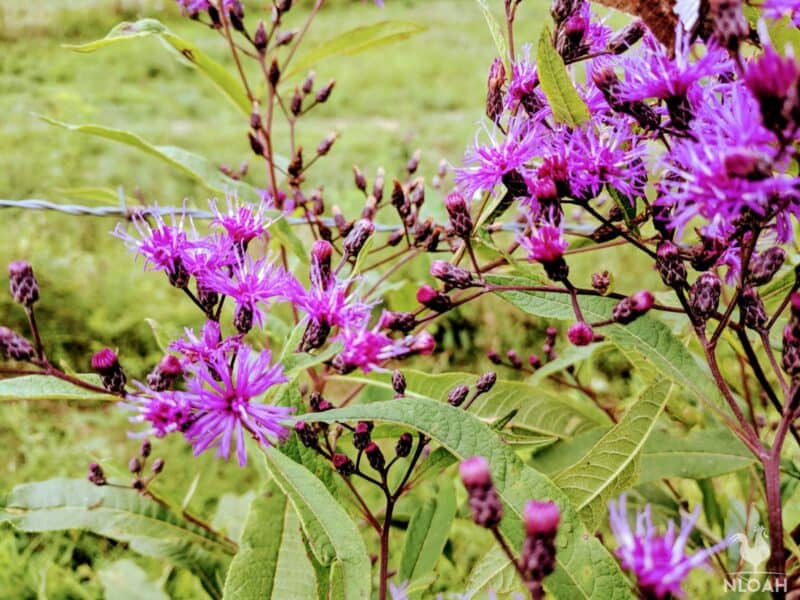
For centuries, ironweed has been used to treat a plethora of health issues, first by Native Americans (the Cherokee tribe in particular) and now by natural medicine fans all around the world.
Native Americans brewed teas from the leaves of the ironweed plant to treat a host of female conditions, as well as using the tea as a blood tonic. The roots from the plant were often used to treat mouth and stomach related problems.
There are multiple varieties or ironweed. This type is also often referred to a “tall ironweed”.
Top 20 Ironweed Medicinal Uses
1. Passing Kidney Stones
2. Menstrual Pain
3. Stomach Ulcers
4. Loose Teeth
5. Hemorrhaging – especially after childbirth
6. General after childbirth pain relief
7. Dandruff
8. Fever
9. Chills
10. Syphilis
11. Skin rashes
12. Appetite Stimulation
13. Sore throat
14. Digestion Regulation
15. Gout
16. Headache
17. Sickle Cell Anemia
18. Blood Impurity
19. Dysphasia
20. Diabetes
A $3 million cancer study involving ironweed is being conducted over the course of five years at the University of Hawaii Cancer Center. Scientific researchers will study how the compounds in ironweed extract could be used to treat (and perhaps even cure) both brain and breast cancers. If the ironweed plant extract performs as aggressively as hoped, it could ultimately be used in place of more conventional forms of cancer treatment, like chemotherapy.
Native Americans also chewed on the leaves for their medicinal value and to use as a type of nicotine style chew.
Ironweed blooms during the late summer months, producing a dense flower head full of purple petals. The scientific name of the wildflower many deem a mere weed, is Vernonia altissima. It was named after English botanist William Vernon who “discovered” ironweed during the late 1600s through early 1700s on a journey through North America.
Ironweed Range And Identifying Characteristics
Ironweed grows naturally from New York through southern Georgia. It is a member of the Asteraceae family due to its tubular shaped flowers. The purple flowers grow in groupings of up to 40 per flower head.
Each little flower boasts a istil, 5 stamens, 5 lobed and tubular corolla, a style, and an inferior ovary.
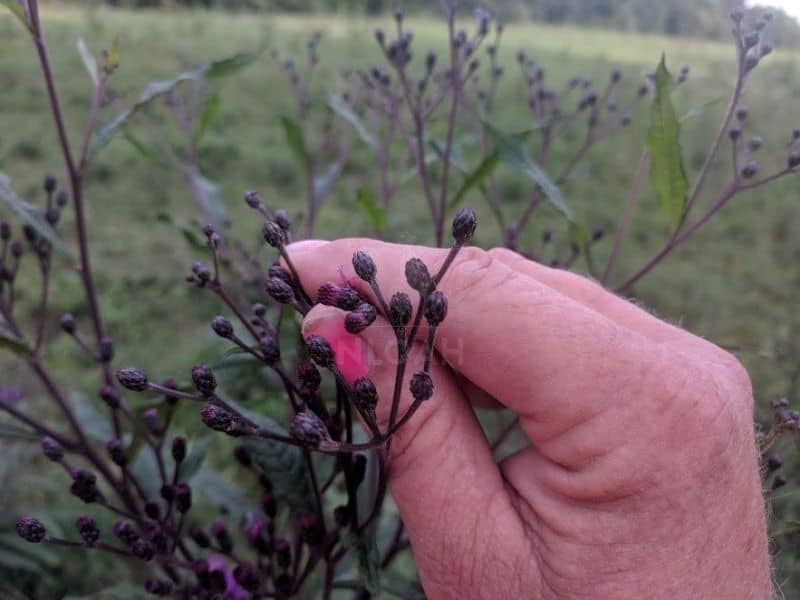
The stems of the ironweed plant are especially coarse and typically grow to at least three feet but often six feet, tall. In some regions of the United States, ironweed that stands up to 10 feet tall have been spotted.
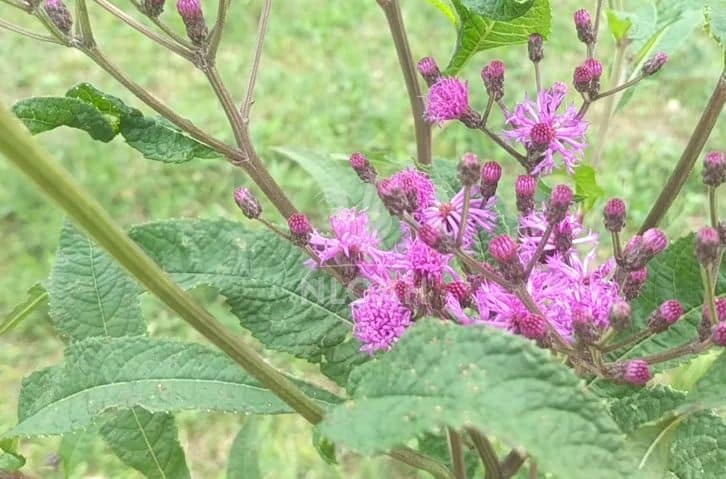
The leaves of the medicinal wildflower range from 3 to 8 inches long. Ironweed leaves boast serrated edges. It’s a perennial plant that has a rather sturdy and well-developed root system.
The durability of the wildflower is likely linked to its naming. You can bend an ironweed plant all the way over to the ground and it just bounces right back up into place almost instantly.
It blooms from July through September, depending upon the region of the country where it is being grown. The foliage will remain on the plant until the first frost of the season. Ironweed typically attracts both butterflies and honeybees in great abundance.
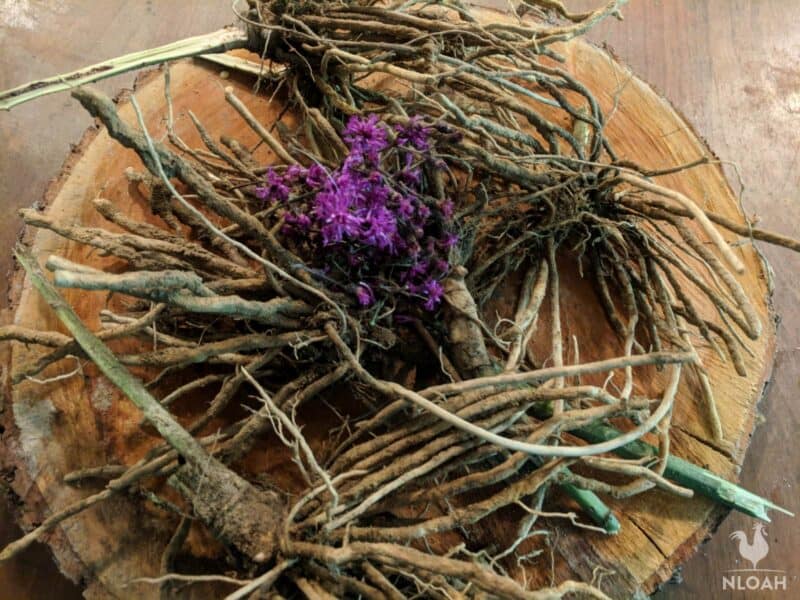
To make a medicinal ironweed tea, mix together eight parts water to 2 parts crushed roots and/or seeds from the wild plant. Boil the mixture together and stir frequently until only about one fourth of the water remains in the pot.
Allow the mixture to cool enough to drink without burning your mouth and then sip on it until the medicinal tea is gone. It is likely you will have to repeat this process twice a day (or three times per day, depending upon the severity of the ailment) for several days to a week.
How To Grow Ironweed
This plant self-sows both frequently and with great ease. It will spread quickly – choose a location for ironweed carefully or be prepared to dig up and transplant new sprouts frequently. Like maple tree pods, ironweed seeds are blown free in the wind and tend to grow wherever they land.
- Ironweed needs to be planted in moist and humus-rich soil.
- Plant the wildflower in a full sun area whether starting it from seed or a cutting.
- Sow ironweed seeds directly outdoors after the threat of the last frost has passed.
- Keep seeds dampened throughout the germination process.
- Once the hardy perennial plant has somewhat matured, it can adapt to a partial shade growing area as well as rebound after being exposed to either slight flooding or drought conditions.
- A soil pH balance of 6/1 to 7/5 is highly recommended.
- The wildflower seeds should be planted 1 to 2 feet apart.
- The average seed germination time is 2 to 3 weeks.
- Sow ironweed seeds only one-eighth to one-fourth of an inch deep in the soil.
- Ironweed can be planted outdoors when air temperature hovers around 65 to 67 degrees F.
- Neither livestock nor typical garden pests tend to munch on ironweed.
- Deadhead the spent ironweed flowers often if you want to attempt to curtail spreading. To deadhead a plant, carefully cut or pinch of the flower stem after the bloom fades. Make sure to separate the flower just above the layer of healthy and thriving leaves to prevent killing the plant.
As always, just because you can pluck something from the earth, that does not mean it is safe to use and consume for everyone.
Although no severe allergic reactions to ironweed are known, that does not mean they cannot happen – especially if the ironweed you pick has been sprayed with a chemical weed killer. Because ironweed often grows in roadway medians and alongside country roads, such spraying is highly likely.
Proper identification of foraged wild edible and natural remedy ingredients is essential to not only their success, but safe use.
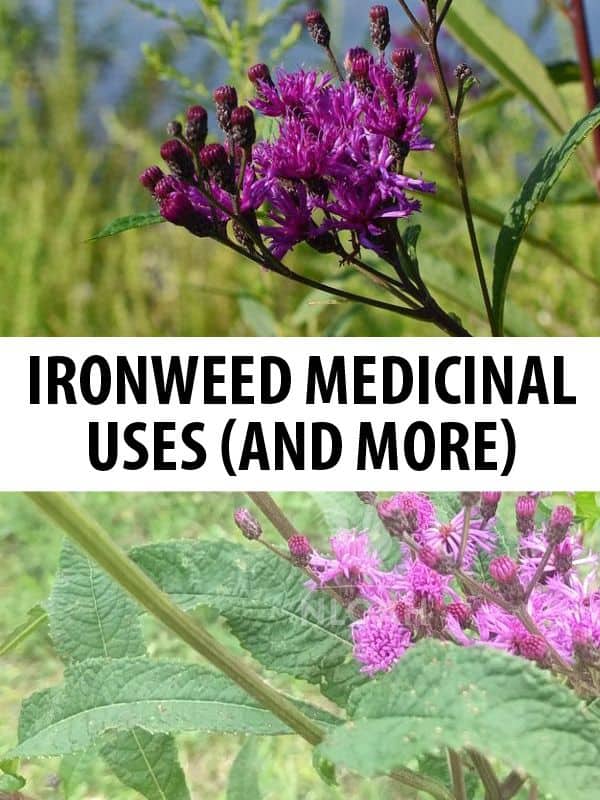

Tara lives on a 56 acres farm in the Appalachian Mountains, where she faces homesteading and farming challenges every single day, raising chickens, goats, horses, and tons of vegetables. She’s an expert in all sorts of homesteading skills such as hide tanning, doll making, tree tapping, and many more.

Can you make a tincture from the roots?
Where can one buy this exact plant? I do see seeds for sale, but it ‘looks like it might be tricky to grow?
I live in the Athens area in TN an would like to no if there’s any forageing classes around that area
Appreciate the thorough information, especially the descriptions of how the plant is used and the tea recipe.
Thank you for all this valuable information! I just discovered Ironweed at a nursery and bought one plant. I loved how tall and strong it looked……. It also had many bees so that’s already a positive.
Looking forward to see it grow. Thank you!
When is the best time to harvest Ironweed? What are the best ways to store for later use?
Hello Marybeth
This answer is a year in getting to you, but here it goes. I teach Foraging classes in Nashville Tn and have a bit of experience with harvesting wild plants. The time of year to harvest a plant depends greatly on what part of the plant you are interested in using. If you want to use the leaves then harvest them before the plant flowers. Once the plant starts to flower then all of its energy goes toward reproduction, and a lot of that energy can come from the roots and leaves.
If you want to harvest the flowers for teas or dyes (etc) then pick them before the start to set seed. If you are after the roots, then it is best to wait until after the first really cold snap and the plant dies back to just roots. This is when the roots are most enriched and potent. You can also wait until late winter to harvest the roots. Once the plants start to grow again in spring, then the stored energy in the roots will be used for that next season’s growth. Leaves are most edible in spring for most perennials.
Of course, personal needs rarely heed seasons, but if you can plan ahead a little bit and harvest by season and stage of growth, then you can maximize your bounty. The roots and flowers of many Ironweeds can also be used to make dyes.
When the purple flowers of Ironweed are in full bloom and used as dye material, they produce a really beautiful dye bath in hues of soft forest green. However, if you use the flowers after their peak, the dye bath creates surprisingly beautiful shades of yellow and buttery gold when alum is used as the mordant. Such a nifty plant to explore. And as with many things in life, timing can make a difference.
I live close to Nashville and would be interested in attending your foraging classes. Are there any upcoming? Thank you for your information on ironweed. I am looking forward to using some that I have growing wild. It is such a beautiful color.
Good Morning Sherri
Thanks for your interest. I am teaching classes almost every week outdoors until winter sets in. Please email me at mywildweedwalks@gmail.com and I’ll let you know about classes. Most of my classes are held when someone wants a class, but I also do group classes. My schedule is open. I write all original material for classes. Now is a great time for late summer foraging. I can cater classes to your interests. Food, medicinal, textile etc. Look forward to hearing from you. Thanks
EOQA Essential Oil Quality Alliance produces Ironweed Hydrosol (Total) and root.